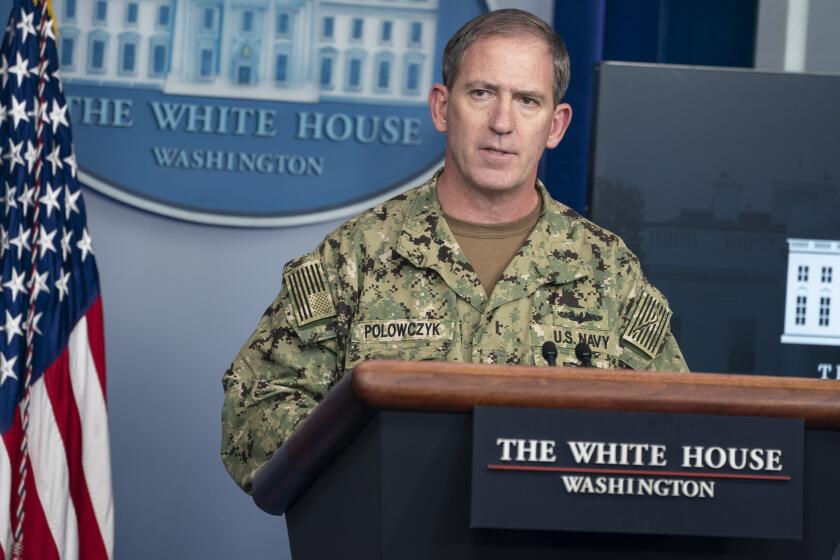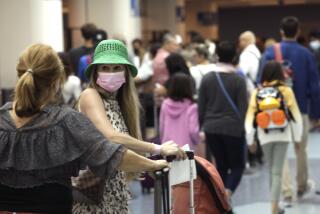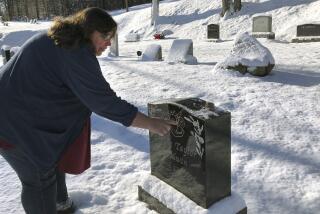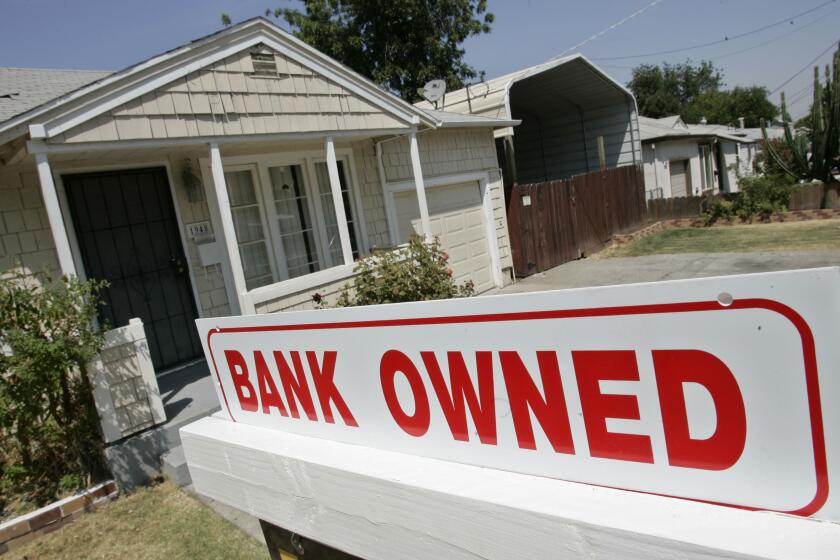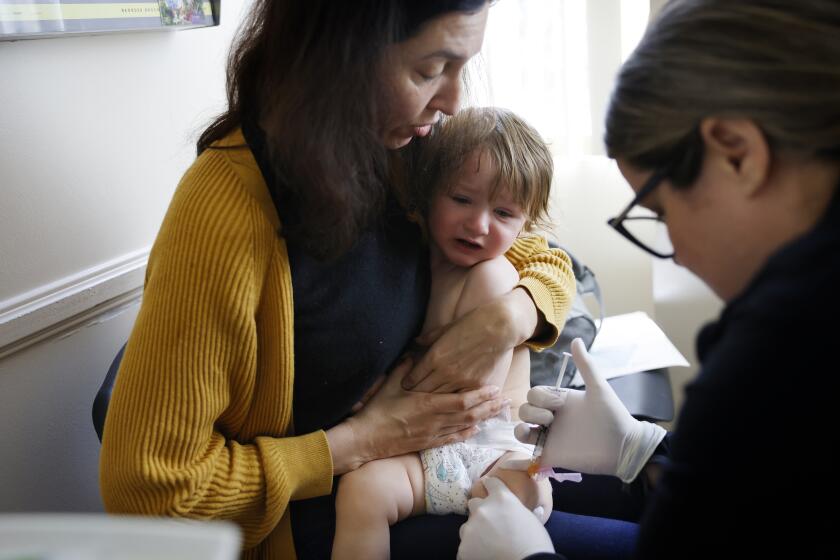New data suggest U.S. coronavirus death toll may not be as high as feared

Public health experts say information about the spread of the novel coronavirus through Texas and Florida in coming days could be crucial in predicting how many Americans are likely to die from the pandemic.
The apparent effects of social distancing in three major hot spots — Italy, New York and California — have given scientists hope that the final U.S. death toll could be lower than White House projections of 100,000 to 240,000, which were based on a combination of models that administration officials have not fully explained.
“I think we’re just doing much better than those numbers,” President Trump said during his daily White House briefing on Wednesday. He warned of “terrible days ahead” but said, as he has before, that there is a “light at the end of the tunnel.”
The Institute for Health Metrics and Evaluation at the University of Washington, which last week projected more than 90,000 American deaths from COVID-19, the disease caused by the coronavirus, lowered its estimate on Wednesday to 60,415 deaths in the period until Aug. 4.
“All of the available information strongly suggests that social distancing policies are making a big difference,” said Dr. Greg Roth, a clinical advisor to the team running the model. “We’ve seen the shape of the death curve in places like New York and Italy sharpen to a much sharper peak.”
At the White House with the president, his coronavirus reponse coordinator, Dr. Deborah Birx, similarly credited Americans for following federal guidelines to avoid public gatherings and stay at home. “We are impressed by the American people,” said Birx, who only recently complained of a lack of compliance with social distancing admonitions.
Robert R. Redfield, director of the Centers for Disease Control and Prevention, agreed, saying, “What’s been remarkable to watch here is how the American public has changed its behavior when it affects the vulnerable.”
But social distancing directives came late in Texas, Florida and some other Southern states, where hospitals also have less capacity. Big spikes in those states, especially if they occur together, could push fatalities higher if hospitals are overwhelmed and if older, more vulnerable patients, particularly in Florida, are stricken.
The masks are among the most coveted supplies needed in hospitals and medical facilities that are treating people infected with the coronavirus amid a nationwide shortage of personal protective equipment for healthcare workers.
The models used to predict sickness and death vary widely and are admittedly faulty, given that they rely on specific assumptions about what people and governments are doing to stop the contagion.
The Institute for Health Metrics and Evaluation — one of the main sources the White House used to inform its numbers — includes data from Wuhan, China, where the government imposed a strict lockdown, isolated infected people from their families and employed thousands of workers to identify and track infected people to quarantine them and monitor their contacts.
Experts say a group of models offering a range of possibilities — the approach used by meteorologists and marketers — is more reliable than a single forecast.
“We don’t do this with hurricane predictions; we don’t even do this with Netflix movie predictions,” said Dylan George, vice president of the tech investment firm In-Q-Tel, who served as a senior White House advisor on biological threats under President Obama.
The Trump administration has only committed to recommending Americans stay at home until April 30. The Institute for Health Metrics and Evaluation assumes such measures will remain in effect for at least a month longer, and public health experts have not settled on a recommended timeline.
As recently as mid-March, top Trump administration officials warned that Italy, where thousands of people were dying and hospitals were overwhelmed, was a worst-case scenario, urging Americans to wash hands and stay home to emulate the success of South Korea in combating the spread of the virus.
But botched U.S. testing and a slow and uneven response by the Trump administration had by then already rendered the South Korean model impossible.
Now Italy, the onetime cautionary tale, has become the goal. Over the weekend, Birx spoke of “hopeful signs in Italy and Spain, where we see, finally, new cases and deaths declining.”
“It’s giving us hope of what our future could be,” she added.
Jeremy Konyndyk, who led the overseas Ebola response for the Obama administration, said the shift in rhetoric shows how “the goal posts have moved” in just a few weeks. But he said Italy would “be a welcome outcome” at this point, “given how bad things have gotten” in the United States.
“We’re going to have hot spots everywhere,” he predicted.
Public health experts believe Italy may be turning the tide. The country, with less than a fifth of the U.S. population, recorded more than 17,000 COVID-19 deaths as of Wednesday, which would translate to more than 90,000 deaths in the U.S. population.
New York’s disease cluster, the epicenter of the U.S. outbreak for weeks, is also showing signs of ebbing. San Francisco, another dense city with an early outbreak, also has seen better than expected results.
But experts urge caution. “We really need to wait a week or two to see if that trend holds,” said George of In-Q-Tel. “We can’t jump the gun on this.”
Public health experts say the outbreaks in Italy and New York ultimately could look relatively benign.
As hospitals battle the coronavirus, they’re baffled as the Trump administration seizes hard-to-stock medical supplies.
Italy has more hospital beds and doctors per capita than the United States. And even as New York’s dense population and busy subway system helped the virus spread, the city has several advantages.
New York has more large and well-resourced hospitals, and its governor was aggressive in imposing stay-at-home measures.
Gov. Andrew Cuomo’s updates, including his frequent pleas for help, have been broadcast nationally on a daily basis, putting pressure on the Trump administration and attracting physicians and supplies from around the country.
If other hot spots develop simultaneously — say, in Dallas, Miami and Phoenix — it’s not clear that they can expect the same level of help, especially if other states see spikes in patients at the same time.
“Will 49 other governors be able to do what Cuomo has done?” asked Dr. Ashish Jha, who directs Harvard University’s Global Health Institute.
Florida, the nation’s third most populous state, is one of the most vulnerable to the pandemic since elderly residents account for nearly a fourth of the population. Gov. Ron DeSantis, a Republican, only issued a statewide stay-at-home order last week, long after most other governors had acted.
“We just hope it’s not too late,” said a senior executive at a large medical system in Florida, who asked not to be identified out of concern about panicking the hospital’s community.
The medical system has projected it will begin to run out of beds and ventilators by the second week of May, even after squeezing beds into every corner of the medical center over the next four weeks.
At that point, physicians and hospital officials would be forced to decide which patients would get ventilators and which would die, a dilemma that a special ethics committee at the medical system is already beginning to discuss.
“That’s the kind of stuff we in hospitals never talk about,” the hospital executive said. “The idea that people like us, our doctors and our nurses, have to consider that there may be thousands that we can’t care for pulls on your soul. It’s not who we are.”
If Floridians stay home and mitigate the spread of the virus, the state’s medical system may not be swamped, however. More consistent social distancing could push off the peak demand for beds and ventilators until the third week of July.
The effort to predict fatalities at the national level is also hampered by the lack of reliable government data and adequate testing, which makes it difficult to know how many Americans have been infected and what the true death rate is.
Many people who died of COVID-19 were never tested, meaning they will not be reflected in the death toll. Other people who carry the virus show no symptoms and are also not counted. But if that number is high, it means more Americans could spread the disease once social distancing ends.
Times staff writer Jaweed Kaleem in Miami and Chris Megerian in Washington contributed to this report.
More to Read
Get the L.A. Times Politics newsletter
Deeply reported insights into legislation, politics and policy from Sacramento, Washington and beyond. In your inbox three times per week.
You may occasionally receive promotional content from the Los Angeles Times.

